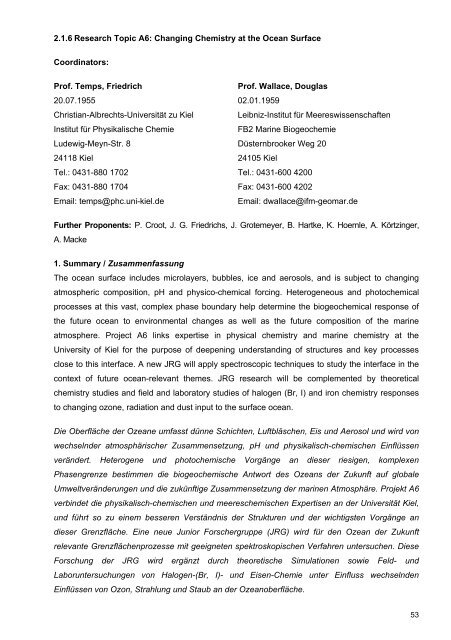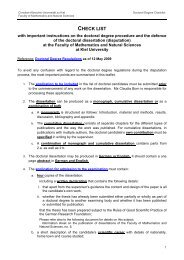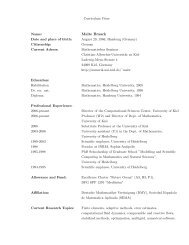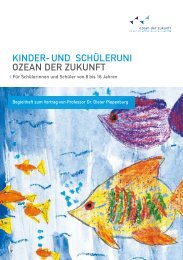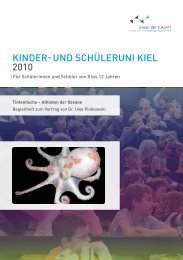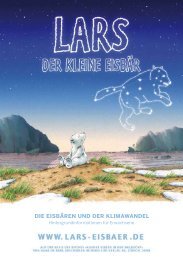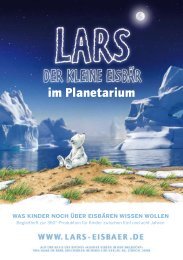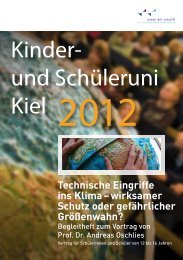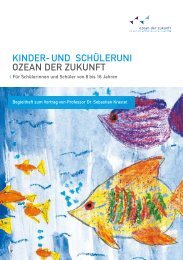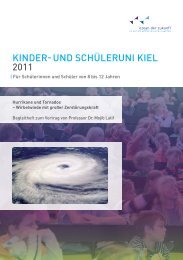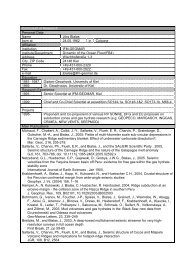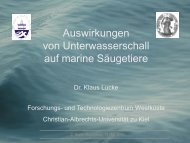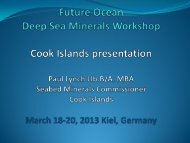Untitled - The Future Ocean
Untitled - The Future Ocean
Untitled - The Future Ocean
- No tags were found...
You also want an ePaper? Increase the reach of your titles
YUMPU automatically turns print PDFs into web optimized ePapers that Google loves.
2.1.6 Research Topic A6: Changing Chemistry at the <strong>Ocean</strong> SurfaceCoordinators:Prof. Temps, FriedrichProf. Wallace, Douglas20.07.1955 02.01.1959Christian-Albrechts-Universität zu KielLeibniz-Institut für MeereswissenschaftenInstitut für Physikalische ChemieFB2 Marine BiogeochemieLudewig-Meyn-Str. 8Düsternbrooker Weg 2024118 Kiel24105 KielTel.: 0431-880 1702Tel.: 0431-600 4200Fax: 0431-880 1704Fax: 0431-600 4202Email: temps@phc.uni-kiel.deEmail: dwallace@ifm-geomar.deFurther Proponents: P. Croot, J. G. Friedrichs, J. Grotemeyer, B. Hartke, K. Hoernle, A. Körtzinger,A. Macke1. Summary / Zusammenfassung<strong>The</strong> ocean surface includes microlayers, bubbles, ice and aerosols, and is subject to changingatmospheric composition, pH and physico-chemical forcing. Heterogeneous and photochemicalprocesses at this vast, complex phase boundary help determine the biogeochemical response ofthe future ocean to environmental changes as well as the future composition of the marineatmosphere. Project A6 links expertise in physical chemistry and marine chemistry at theUniversity of Kiel for the purpose of deepening understanding of structures and key processesclose to this interface. A new JRG will apply spectroscopic techniques to study the interface in thecontext of future ocean-relevant themes. JRG research will be complemented by theoreticalchemistry studies and field and laboratory studies of halogen (Br, I) and iron chemistry responsesto changing ozone, radiation and dust input to the surface ocean.Die Oberfläche der Ozeane umfasst dünne Schichten, Luftbläschen, Eis und Aerosol und wird vonwechselnder atmosphärischer Zusammensetzung, pH und physikalisch-chemischen Einflüssenverändert. Heterogene und photochemische Vorgänge an dieser riesigen, komplexenPhasengrenze bestimmen die biogeochemische Antwort des Ozeans der Zukunft auf globaleUmweltveränderungen und die zukünftige Zusammensetzung der marinen Atmosphäre. Projekt A6verbindet die physikalisch-chemischen und meereschemischen Expertisen an der Universität Kiel,und führt so zu einem besseren Verständnis der Strukturen und der wichtigsten Vorgänge andieser Grenzfläche. Eine neue Junior Forschergruppe (JRG) wird für den Ozean der Zukunftrelevante Grenzflächenprozesse mit geeigneten spektroskopischen Verfahren untersuchen. DieseForschung der JRG wird ergänzt durch theoretische Simulationen sowie Feld- undLaboruntersuchungen von Halogen-(Br, I)- und Eisen-Chemie unter Einfluss wechselndenEinflüssen von Ozon, Strahlung und Staub an der Ozeanoberfläche.53


